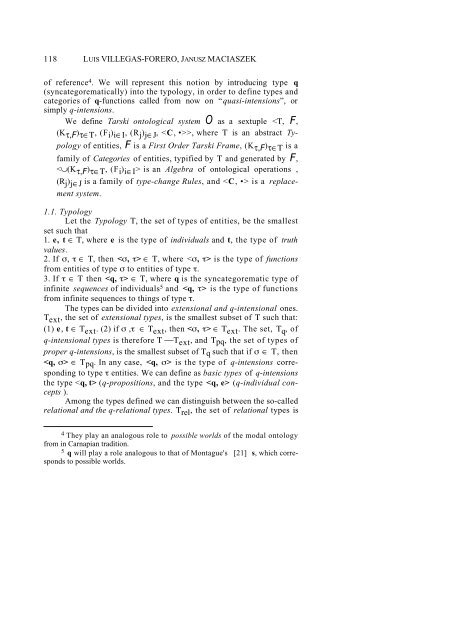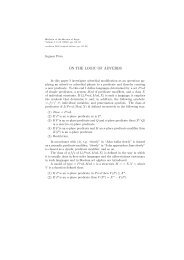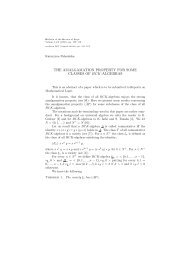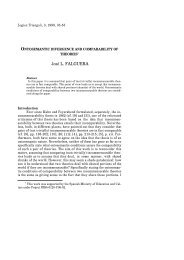Luis VILLEGAS-FORERO, Janusz MACIASZEK
Luis VILLEGAS-FORERO, Janusz MACIASZEK
Luis VILLEGAS-FORERO, Janusz MACIASZEK
Create successful ePaper yourself
Turn your PDF publications into a flip-book with our unique Google optimized e-Paper software.
118 LUIS <strong>VILLEGAS</strong>-<strong>FORERO</strong>, JANUSZ <strong>MACIASZEK</strong><br />
of reference 4 . We will represent this notion by introducing type q<br />
(syncategorematically) into the typology, in order to define types and<br />
categories of q-functions called from now on “quasi-intensions”, or<br />
simply q-intensions.<br />
We define Tarski ontological system O as a sextuple , where Τ is an abstract Ty-<br />
pology of entities, F is a First Order Tarski Frame, (K τ,F ) τ∈Τ is a<br />
family of Categories of entities, typified by Τ and generated by F,<br />
is an Algebra of ontological operations ,<br />
(R j ) j∈J is a family of type-change Rules, and is a replace-<br />
ment system.<br />
1.1. Typology<br />
Let the Typology Τ, the set of types of entities, be the smallest<br />
set such that<br />
1. e, t ∈ Τ, where e is the type of individuals and t, the type of truth<br />
values.<br />
2. If , ∈ Τ, then < , > ∈ Τ, where < , > is the type of functions<br />
from entities of type to entities of type .<br />
3. If ∈ Τ then ∈ Τ, where q is the syncategorematic type of<br />
infinite sequences of individuals 5 and is the type of functions<br />
from infinite sequences to things of type .<br />
The types can be divided into extensional and q-intensional ones.<br />
Τ ext , the set of extensional types, is the smallest subset of Τ such that:<br />
(1) e, t ∈ Τ ext . (2) if , ∈ Τ ext , then < , > ∈ Τ ext . The set, Τ q , of<br />
q-intensional types is therefore Τ ⎯Τ ext , and Τpq, the set of types of<br />
proper q-intensions, is the smallest subset of Τq such that if ∈ Τ, then<br />
∈ Τpq. In any case, is the type of q-intensions corresponding<br />
to type entities. We can define as basic types of q-intensions<br />
the type (q-propositions, and the type (q-individual concepts<br />
).<br />
Among the types defined we can distinguish between the so-called<br />
relational and the q-relational types. Τ rel , the set of relational types is<br />
4 They play an analogous role to possible worlds of the modal ontology<br />
from in Carnapian tradition.<br />
5 q will play a role analogous to that of Montague's [21] s, which corresponds<br />
to possible worlds.






